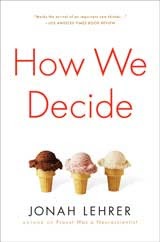 Last night's post about Marilyn vos Savant's envelope challenge reminded me I never got around to posting about Jonah Lehrer's neat book How We Decide. Here are a few quotes and choice bits.
Last night's post about Marilyn vos Savant's envelope challenge reminded me I never got around to posting about Jonah Lehrer's neat book How We Decide. Here are a few quotes and choice bits.
Downsides of Dopamine
Lehrer devotes a chapter to dopamine, a neurotransmitter that regulates all of our emotions, from love to disgust. Rewards that arrive in a patterned way (think Pavlov's dog) trigger a dopamine burst in our brains. These patterns and our response to them are often what we think of as intuition -- we're recognizing patterns without realizing it. And when the pattern fails to behave as expected, the brain, in effect, gets annoyed and stops the dopamine response.
Lehrer gives the example of a woman who developed Parkinson's disease, which causes dopamine receptors to die. When she went on medication that imitates the activity of dopamine, it not only improved her movement ability, it also caused her to become addicted to slot machines. After a straight-arrow life of 52 years, she lost her retirement funds, possessions, and husband. When she went off the medication, her compulsive use of one-armed bandits disappeared.
This is because of the nature of slot machines:
while dopamine neurons get excited by predictable results...they get even more excited by surprising ones... The purpose of this dopamine surge is to make the brain pay attention to new, and potentially important, stimuli...According to Lehrer, there are twice as many slot machines in the U.S. as there are ATMs. Sounds like a prescription for people wasting their money and possibly ruining their lives, huh?
Most of the time, the brain will eventually get over its astonishment. It'll figure out which events predict the reward, and the dopamine neurons will stop releasing so much of the neurotransmitter. The danger of slot machines, however, is that they are inherently unpredictable...
At this point, the dopamine neurons should just surrender: the slot machine is a waste of mental energy... But that isn't what happens. Instead of getting bored by the haphazard payouts, the dopamine neurons become obsessed...
For Parkinson's patients on dopamine agonists, the surprising rewards of the casino trigger a massive release of chemical bliss (pages 60-61).
Dopamine also fools us into thinking that basketball players can be shooting on a "hot streak," to think that we can beat the stock market, and to feel something called "loss aversion," where we experience losses as twice as potent as gains. Loss aversion is "part of a larger psychological phenomenon known as negativity bias, which means that, for the human mind, bad is stronger than good. This is why in marital interactions, it generally takes at least five kind comments to compensate for one critical comment" (page 81).
Loss Aversion
Credit cards exploit elements of our natural tendency toward loss aversion. When we spend cash, we feel as if we have lost something -- which we have, even though we have also gained the product we bought. "Brain imaging experiments suggest that paying with credit cards actually reduces activity in the insula, a brain region associated with negative feelings" (page 86). Pay with cash, feel bad; pay with credit, feel good -- as if you got something for nothing. Lehrer gives an examples of an auction for Boston Celtics tickets, where half the bidders were told to pay in cash, and half with credit. The average credit card bid was twice the average cash bid.
The idea that we are all "rational men" is clearly not a reality for the human brain. And it's not really anyone's fault if they fall for these illusions -- we're wired that way. The solution may be what's called "asymmetric paternalism," which Lehrer describes as "creating policies and incentives that help people triumph over their irrational impulses and make better, more prudent decisions" (page 91).
Contradictions Are Key
Another irrational tendency of our brains is the need to repress inner contradictions. Lehrer tells about experiments where people with no connection between their brain hemispheres are shown two different photos, isolated for view by only one of their eyes. Then the subjects are shown a number of images to both eyes, and asked to pick the one that is most closely associated with the previous image they saw. Subjects will point to two different images, one with each hand. So far, so to be expected. But then, instead of admitting the confusion, the subjects make up an additional connection between the two images:
Instead of admitting that his brain was hopelessly confused, the patient wove his confusion into a plausible story. In fact, the researchers found that when patients made especially ridiculous claims, they seemed even more confident than usual (page 211).This may sound familiar (cognitive dissonance, anyone?). The only solution, of course, is to encourage your own inner dissonance. "We must force ourselves to think about the information we don't want to think about, to pay attention to the data that disturbs our entrenched beliefs" (page 217).
I encourage everyone to read How We Decide. And while you're trying to get your hands on a copy, you can get a head start by reading the blog You Are Not So Smart. YANSS is written by a young journalist who posts essays full of great examples, covering a range of brain illusions.


No comments:
Post a Comment